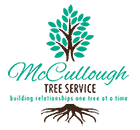By: Shelby McCullough| Published: July 1, 2024
Understanding the life cycle and health of trees is crucial for any property owner. Trees are not just aesthetic elements; they contribute to the ecosystem and provide numerous benefits. However, when a tree shows signs of distress, it’s essential to understand whether it can be saved or if removal is necessary. Let’s explore the signs of a dying tree, possible interventions, and when it’s time to call a professional.

Signs of a Dying Tree
Recognizing the symptoms of a dying tree early can often make the difference between saving it and having to remove it. Here are some common signs:
- Leaf Discoloration and Wilting
- Leaves turning yellow or brown out of season.
- Premature leaf drop.
- Bark Issues
- Bark peeling or falling off.
- Deep cracks or splits in the trunk.
- Fungal Growth
- Mushrooms growing at the base or on the tree itself.
- Dead Branches
- Large branches that are bare or breaking easily.
- Root Damage
- Exposed roots or roots that are decayed and brittle.
By regularly inspecting your trees for these symptoms, you can act promptly to address any issues.

Causes of Tree Decline
Understanding why a tree is dying is the first step in saving it. Here are common causes of tree decline:
- Pests and Diseases
- Insects such as borers and beetles.
- Diseases like oak wilt, Dutch elm disease, and root rot.
- Environmental Stress
- Drought conditions or excessive moisture.
- Soil compaction and poor drainage.
- Physical Damage
- Storm damage or mechanical injury from construction.
- Nutrient Deficiencies
- Lack of essential nutrients in the soil.
Interventions to Save a Dying Tree
Once the cause is identified, specific interventions can be implemented. Here are effective strategies:
- Watering and Mulching
- Deep watering during dry periods.
- Mulching to retain soil moisture and regulate temperature.
- Fertilization
- Using slow-release fertilizers to provide essential nutrients.
- Pruning
- Removing dead or diseased branches to promote healthy growth.
- Pest and Disease Control
- Applying appropriate pesticides or fungicides.
- Introducing beneficial insects to control harmful pests.
- Soil Aeration
- Aerating the soil to improve root growth and soil structure.
Example: If a tree is suffering from root rot, improving drainage and reducing watering frequency can help prevent further damage.

When to Call a Professional Arborist
While some tree issues can be handled by homeowners, others require professional expertise. Here’s when you should call an arborist:
- Large Scale Infestations or Diseases
- When the problem affects a significant portion of the tree.
- Structural Damage
- If the tree poses a risk to property or people.
- Uncertain Diagnosis
- When it’s unclear what is causing the decline.
An arborist can provide a detailed assessment and recommend specific treatments or removal if necessary.
Benefits of Professional Tree Care
Hiring a professional tree service, like McCullough Tree Service, offers several benefits:
- Expert Diagnosis
- Accurate identification of tree issues and effective solutions.
- Safety
- Safe removal of hazardous trees and branches.
- Long-Term Health
- Implementing preventative care measures to ensure the longevity of your trees.
FAQs
Q: Can all dying trees be saved?
A: Not all dying trees can be saved. The possibility depends on the extent of the damage and the underlying cause. Early detection and intervention increase the chances of saving a tree.
Q: How often should I inspect my trees?
A: It’s advisable to inspect your trees at least twice a year, in spring and fall, to catch any issues early.
Q: What are the costs associated with tree care?
A: Costs vary depending on the services required. Basic pruning and fertilization are relatively inexpensive, while pest control and removal can be more costly.
Q: Can I treat tree diseases myself?
A: Minor issues can often be handled with over-the-counter treatments, but significant infestations or diseases typically require professional intervention.
Q: What should I do if a tree is near power lines?
A: Never attempt to prune or remove trees near power lines yourself. Always contact a professional tree service with the proper equipment and expertise.
Q: How do I choose the right arborist?
A: Look for certified arborists with positive reviews and a solid reputation. McCullough Tree Service, for instance, offers certified professionals with extensive experience.
Conclusion
The health of your trees is vital to your property’s overall aesthetics and the environment. Regular inspections, proper care, and timely interventions can often save a dying tree. However, when in doubt, consulting with a professional arborist can ensure the best outcomes for your trees. Remember, trees are long-term investments that require ongoing care and attention.
For any tree care needs in Central Florida, McCullough Tree Service offers expert services to help you maintain the health and beauty of your landscape. Contact us today for a consultation and let us help you preserve your green investments.

